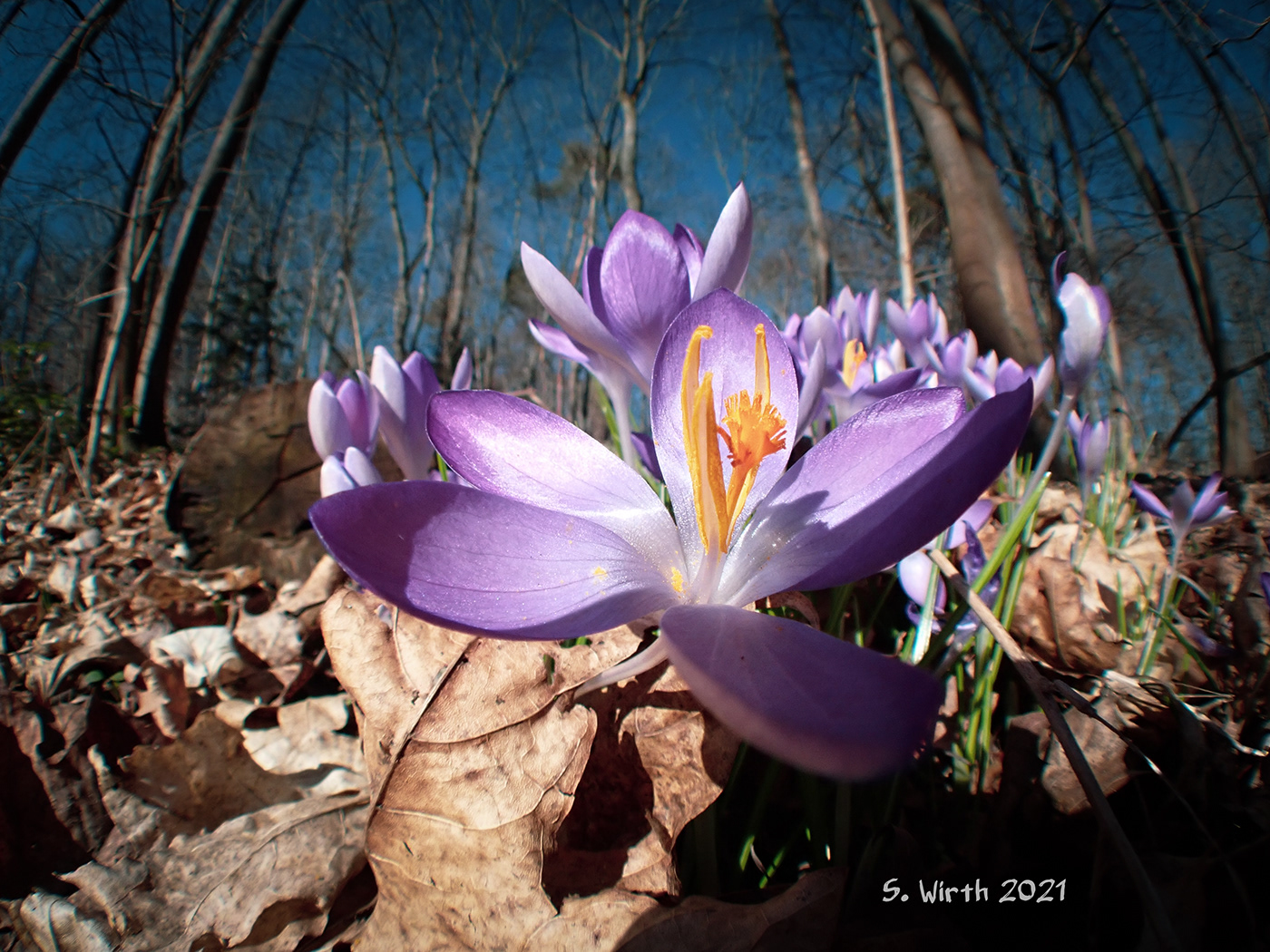
Crocus sp. blooming in fisheye perspective
Micro survivors in deadwood
The late winter 2021 did not end abruptly. While early blooming plants ignored the cold and were not even harmed during snowfall in early April, other life became not less active, but stayed hidden.


Detail of Crocus sp.
The forests in urban park Rehberge were partly exposed to natural conditions including deadwood in form of felled tree trunks and tree stumps.

Dead wood is a very favored hideaway for many organisms, most of them being of microscopic size. Organisms being enabled to digest cellulose fuse it as food source and even as major habitat, where they spend their lives. Fissures in the decomposing wood or the space behind the bark and also the bark itself offer protection and warmth isolation for all those periodical or permanent inhabitants.

Deadwood and play of light and shadows

Web cocoon of an unknown insect under bark of deadwood as macro shot
Some organisms live from those, who digest wood. Cellulose incorporating fungi can offer food sources for bacteria, mites or some insects. But even insects can digest wood, some needing for this purpose a symbiosis with specific bacteria inside their intestines.

Decomposing leaf in between moss cushion in macro perspective

Moss sporophyt in macro optic

Seemingly an insect egg in macro view

Isopod Oniscus asellus under the bark of a felled Tilia platyphyllos


Mites taking a ride on insects
How do very tiny animals disperse, when they have no wings? They could use the wind to get blown into far away new habitats, but they also might simply walk, in case they are well protected against dehydration.

Adult beetle of Phosphuga atrata under bark of felled Tilia platyphyllos at the beginning of March 2021 in park Rehberge, Berlin


Mites of the Astigmata (Acariformes) are very tiny, can't fly by themselves and dehydrate too fast and thus don't walk by themselves over greater distances.

They perform a specific strategy: taking a ride on bigger animals with some preferences for winged insects. For that purpose, a specific instar with suckers on their undersides attach to suitable carriers. This strategy is called phoresy. Phoretic organisms do not directly harm their carriers. But they might introduce harming fungus spores into the insect nest. This is known for some bark beetle mites.

Young larva of beetle Cucujus cinnaberinus under bark of a felled Tilia platyphyllos in park Rehberge, Berlin, beginning of March 2021
I found in beginning of March 2021 two adults of the beetle Phosphuga atrata of unknown genders close to each other under the bark of felled tree trunk of Tilia platyphyllos in urban park Rehberge in Berlin. They sat adjacent to an isopod of Oniscus asellus and several young larvae of Cucujus cinnaberinus.
Video about hibernating and awakening life in early spring and the phoretic mites on Phosphuga atrata and Cucujes cinnaberinus larvae, partly in microscopic perspectives, all copyrights Stefan F. Wirth
P. atrata and C. cinnaberinus larvae had passengers, with which they shared their winter rest: P. atrata had deutonymphs of the mites Schwiebea cf. nova and Schwiebea cf. eurynymphae on the dorsal lateral edges of the elytrae and more rarely also on coxae on the beetle's undersides.
Larvae of Cucujus cinnaberinus also were covered, mostly attached to the legs, with mite deutonymphs.

Gallery under the bark of a felled pine tree, seemingly of the bark beetle Ips typographus


Forest
Towards April the forest changed its colors remarkably, blooming everywhere, butterflies, bees and birds creating a sound of spring and new life.


Dog Hank inside a forest area in urban park Rehberge in Berlin



A felled birch tree in park Rehberge in Berlin


Portrait of young male dog Hank
Milder temperatures even in the evenings, people visiting the parks of the German capital. The smells of moist wood, mosses and early flowers as proof for an actively living young nature.

Wild boar Sus scrofa in an enclosure in park Rehberge, Berlin March 2021


Willow Salix sp.
All copyrights Stefan F. Wirth, Berlin March/April 2021




